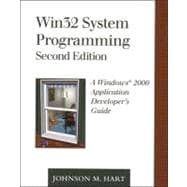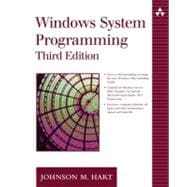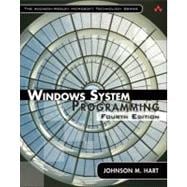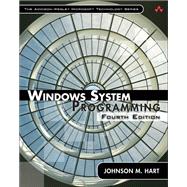Win32 System Programming A Windows 2000 Application Developer's Guide

Win32 System Programming A Windows 2000 Application Developer's Guide
- ISBN 13:
9780201703108
- ISBN 10:
0201703106
- Edition: 2nd
- Format: Hardcover
- Copyright: 09/22/2000
- Publisher: Addison-Wesley Professional
- Newer Edition
Note: Supplemental materials are not guaranteed with Rental or Used book purchases.
Extend or Purchase Your Rental at Any Time
Need to keep your rental past your due date? At any time before your due date you can extend or purchase your rental through your account.
Summary
The Win32 API is supported by Microsoft's family of 32-bit operating systems: Windows 2000, Windows NT, Windows 98, Windows 95, and Windows CE. Win64, to be supported as a 64-bit interface on Windows 2000, is very similar, and migration issues are discussed as required. There is no doubt that Win32, along with Win64, is an important factor for application developers, in many cases replacing UNIX as the preferred API for application programs targeted at desktop and server systems. Many observers predict that Win32 will become the dominant programming interface, although it appears that UNIX and Win32 will continue to coexist and that each will find its own niche.
Regardless of the outcome of the operating system wars, many experienced programmers will want to learn the Win32 API quickly, and this book is designed to help them do so.
The first objectives are to explain what Win32 is, show how to use it in realistic situations, and do so as quickly as possible without burdening the reader with unnecessary detail. This book is, therefore, not comprehensive, but it explains the central features of the most important functions and shows how to use them in realistic programming situations. Equipped with this knowledge, the reader will be able to use the comprehensive Microsoft reference documentation to explore details, advanced options, and the more obscure functions as requirements or interests dictate. I have found the Win32 API easy to learn using this approach, and I have greatly enjoyed developing Win32 programs, despite occasional frustration. This enthusiasm will show through at times, as it should. This does not mean that I feel that Win32 is necessarily better than other operating system APIs, but it certainly has many attractive features.
Many Win32 books assume that the user is familiar only with 16-bit Windows 3.1 programming. These books spend a great deal of time explaining how processes, virtual memory, interprocess communication, and preemptive scheduling work without showing how to use them in realistic situations. A programmer experienced in UNIX, VAX VMS, IBM MVS, or another high-end operating system--that is, nearly anything other than the long-obsolete Windows 3.1 Win16 API--will be familiar with these concepts and will be impatient to find out how they are implemented in Win32. Most Win32 books also spend a great deal of space on user interface programming. This book avoids the user interface, beyond discussing simple character-based console I/O, in the interest of concentrating on the important core features.
This book takes the point of view that Win32 is just an operating system (OS) API, providing a well understood set of features. Many programmers, regardless of experience level, need to learn Win32 and the Windows operating systems quickly, and an understanding of Win32 is invaluable in discussing subjects such as Microsoft's Component Object Model (COM). The Windows systems, when compared with other systems, have good, bad, and average features and quality. The purpose of this book is to show how to use those features efficiently and in realistic situations to develop useful, high-quality, and high-performance applications.
Audience
- Anyone who has experience programming in UNIX or another operating system, even Windows 3.1, and who wants to learn about Win32 quickly.
- Programmers and software engineers who must port existing applications, often in UNIX, to Win32 for operation under Windows 2000 or any of the other Windows platforms. This book contains many comparisons among Win32, UNIX, and standard C library functions and programming models. All common UNIX functionality, including process management, synchronization, file systems, and interprocess communication, is covered in Win32 terms.
- Programmers who are developing servers or other systems or components in which management of resources such as processes and threads is of primary importance and in which the user interface is of secondary importance.
- Programmers using COM or DCOM will find much of the information here helpful in understanding COM's DLL usage, thread models, interfaces, and synchronization.
- Readers starting new projects who are not constrained by the need to port existing code. Many aspects of program design and implementation are covered, and Win32 functions are used to create useful applications and to solve common programming problems.
- Computer science students at the upperclass undergraduate or beginning graduate level in courses covering systems programming or application development. This book will also be useful to those who are learning multithreaded programming or need to build networked applications. This book would be a useful complementary text to a book such as W. Richard Stevens' Advanced Programming in the UNIX Environment (see the Bibliography) so that students could compare Win32 and UNIX. Students in operating systems courses will find this book to be a useful supplement as it illustrates how a commercially important operating system provides essential OS functionality.
The only other assumption, implicit in all the others, is a knowledge of C programming.
Organization
Chapters are organized topically so that the features required in even a single-threaded application are covered first, followed by process and thread management features, and finally network programming in a multithreaded environment. This organization allows the reader to advance logically from file systems to security, memory management, and file mapping, and then to processes, threads, and synchronization, followed by interprocess and network communication. This organization also allows the examples to evolve in a natural way, much as a developer might create a simple prototype and then add additional capability. The advanced features, such as asynchronous I/O, appear last.
Within each chapter, after introducing the functionality area, such as process management or memory-mapped files, we discuss important Win32 functions and their relationships in detail. Illustrative examples follow. Within the text, only essential parts of programs are listed; complete programs and the required include files, utility functions, and the like are in an appendix or on the disc provided with the book. Throughout, we identify those features supported only by Windows 2000 and NT, because Windows 98, 95, and CE do not implement many advanced features. Each chapter suggests related additional reading and gives some exercises. Many exercises address interesting and important issues that did not fit within the normal text, and others allow the reader to explore advanced or specialized topics.
Chapter 1 is a high-level introduction to the Windows OS family and Win32. A simple example program shows the basic elements of Win32 programming style and lays the foundation for more advanced Win32 features. Win64 and migration issues are introduced in Chapter 1, described ex









